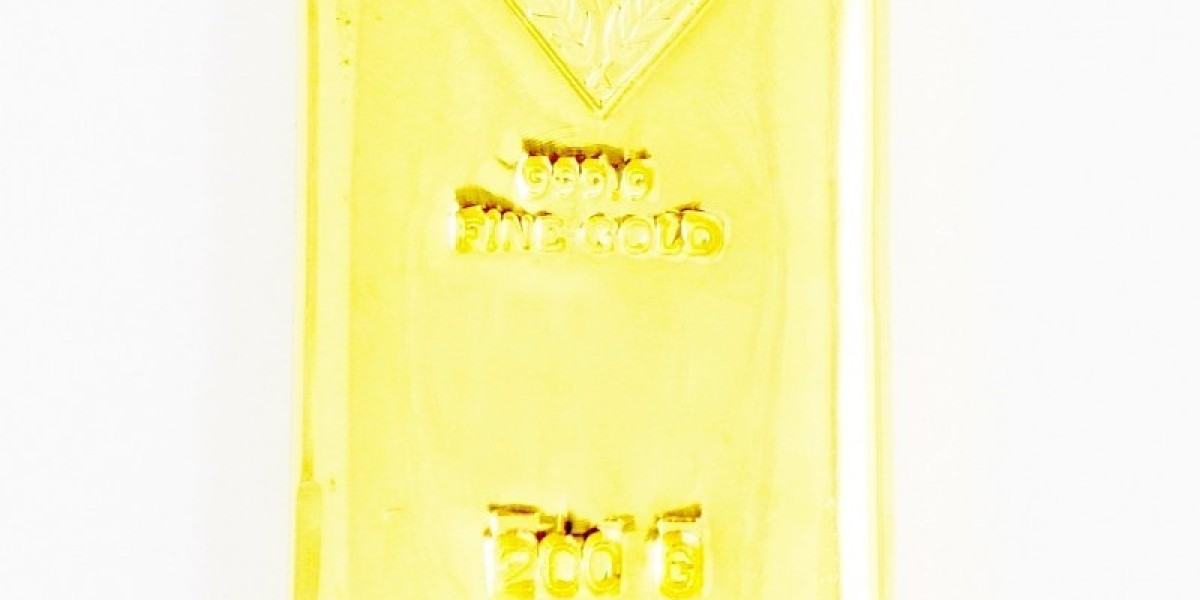The 200-gram gold bar is a popular investment choice among those looking for a substantial, yet manageable, quantity of gold in their portfolio. Understanding the price of a 200-gram gold bar and the factors that influence it can help investors make more informed decisions, particularly given the gold price 200 gram fluctuating nature of the gold market.
In this article, we’ll explore how the price of a 200-gram gold bar is calculated, what factors influence its value, and the best practices for purchasing this investment-grade bullion.
What Determines the Gold Price of a 200 Gram Bar?
The price of a 200-gram gold bar is derived primarily from two components: the current spot price of gold and the premium associated with manufacturing, packaging, and other logistical costs. Here’s a breakdown of how it works:
Spot Price of Gold: The spot price of gold is the per-gram price of pure gold based on global supply and demand, set by international gold markets. This price changes daily and is influenced by various economic factors, including inflation, currency exchange rates, and geopolitical events.
Calculation Example: For example, if the current spot price is ₹5,500 per gram, the raw price of a 200-gram gold bar would be calculated as:
200 grams×5,500 (price per gram)=₹1,100,000200 \text{ grams} \times 5,500 \text{ (price per gram)} = ₹1,100,000200 grams×5,500 (price per gram)=₹1,100,000Premium: The final price of the 200-gram gold bar includes a premium over the spot price, which varies depending on the brand, purity, dealer, and packaging. For investment-grade bars, the premium is typically between 2% to 4%.
Adding a 3% premium to our example:
1,100,000×1.03=₹1,133,0001,100,000 \times 1.03 = ₹1,133,0001,100,000×1.03=₹1,133,000
The total cost of a 200-gram gold bar would thus be approximately ₹1,133,000.
Factors Affecting the 200 Gram Gold Bar Price
Several key factors drive changes in the price of a 200-gram gold bar:
International Gold Market Trends: Gold is a global commodity, and prices are influenced by international trends. For instance, when global demand for gold rises due to economic uncertainties, the price tends to increase. Conversely, in stable economic periods, prices may stabilize or decrease.
Currency Exchange Rates: Gold prices in India are directly affected by the INR-USD exchange rate. A stronger rupee makes gold relatively cheaper, while a weaker rupee raises prices since gold is traded in USD globally.
Local Import Duties and Taxes: As one of the largest gold importers, India imposes duties and taxes on imported gold, including a customs duty and the Goods and Services Tax (GST). These taxes increase the final cost of gold bars. Import duty and GST combined can account for up to 15% of the final price.
Supply and Demand in India: Seasonal and cultural demand in India, especially around major festivals and wedding seasons, significantly affects local gold prices. High demand often leads to a temporary increase in prices due to limited supply.
Dealer Premiums: Different dealers charge varying premiums on the gold bars they sell. Larger bars like the 200-gram bar generally have lower premiums per gram than smaller bars, making them a cost-effective choice for larger investments.
Where to Buy a 200 Gram Gold Bar?
Purchasing a 200-gram gold bar involves choosing a reliable seller, who can ensure you’re receiving authentic, investment-grade gold. Here are some common options:
Bullion Dealers: Specialized bullion dealers like MMTC-PAMP, RSBL (RiddiSiddhi Bullions Ltd.), and online platforms such as Augmont provide certified gold bars, including 200-gram options. These dealers often offer competitive premiums and guarantee purity with assay certificates.
Banks: Some banks sell gold bars, though typically in smaller quantities. In countries like India, banks do not offer buyback services, and premiums may be higher than those of bullion dealers.
Jewelry Stores: Established jewelry chains like Tanishq and Malabar Gold also offer gold bars. However, these may come with higher premiums due to the branding and luxury experience, but many buyers find it a reliable option for smaller and medium-sized bars.
Online Gold Marketplaces: Many investors now turn to online gold retailers for their convenience and transparency. When buying online, verify that the platform provides certifications and secure payment options to ensure authenticity.
Tips for Buying a 200 Gram Gold Bar
Investing in a 200-gram gold bar is a significant financial decision. Here are some tips to help ensure a successful purchase:
Verify Purity: Investment-grade gold bars are generally 24K (99.99% pure). Reputable brands like PAMP Suisse, Valcambi, and the Royal Canadian Mint offer certification of purity and tamper-evident packaging for secure purchases.
Check Dealer Reputation: Choose dealers with positive customer reviews, strong market reputations, and affiliations with industry bodies like the Indian Bullion and Jewellers Association (IBJA). A trusted dealer ensures a fair price and high-quality product.
Compare Premiums: Premiums can vary between dealers, so it’s wise to compare prices before making a purchase. Lower premiums mean a better value for your investment, so weigh the options based on the brand, certification, and packaging.
Watch the Market: Gold prices fluctuate regularly, so timing your purchase can save money. Some investors track price trends and buy during periods of lower rates or economic downturns to maximize their return potential.
Consider Storage: Gold is a valuable asset, so secure storage is essential. Options include home safes, bank lockers, and third-party vaulting services. Some online gold dealers also offer storage options for a nominal fee.
Selling a 200 Gram Gold Bar
If you ever decide to sell your 200-gram gold bar, here are steps to ensure a fair resale value:
Know the Current Market Rate: Gold prices fluctuate, so check the latest rates before selling. Timing your sale during a price peak can help you maximize returns.
Choose a Reliable Buyer: Banks typically do not buy back gold bars in India, so selling to a bullion dealer or jewelry store is usually the best option. Some bullion dealers offer buyback services at competitive rates, ensuring a fair resale price.
Bring Certifications: If your gold bar has an assay certificate gold price 200 gram or tamper-evident packaging, it will likely be easier to sell and fetch a higher price. Certified gold bars from reputable brands are more attractive to buyers.
Advantages of Investing in a 200 Gram Gold Bar
Investing in a 200-gram gold bar offers distinct benefits, especially for those looking to hold physical assets:
Lower Premiums: Larger gold bars, such as 200 grams, have a lower premium per gram compared to smaller bars or coins, making them a cost-effective option for serious investors.
Tangible Wealth: Gold bars offer a physical, tangible form of wealth that has historically maintained value across economic cycles, making it a popular choice during times of inflation or currency devaluation.
High Liquidity: Gold bars are widely recognized and can be easily sold in global markets, especially when they come from certified mints with established reputations.
Conclusion
A 200-gram gold bar is a valuable investment for those looking to diversify their portfolio with a tangible asset. Understanding the price composition, including the spot price of gold and dealer premiums, can help you navigate the gold market more effectively. By purchasing from reputable dealers, verifying certifications, and monitoring market trends, you can make a sound investment that serves as a stable store of value for years to come.








